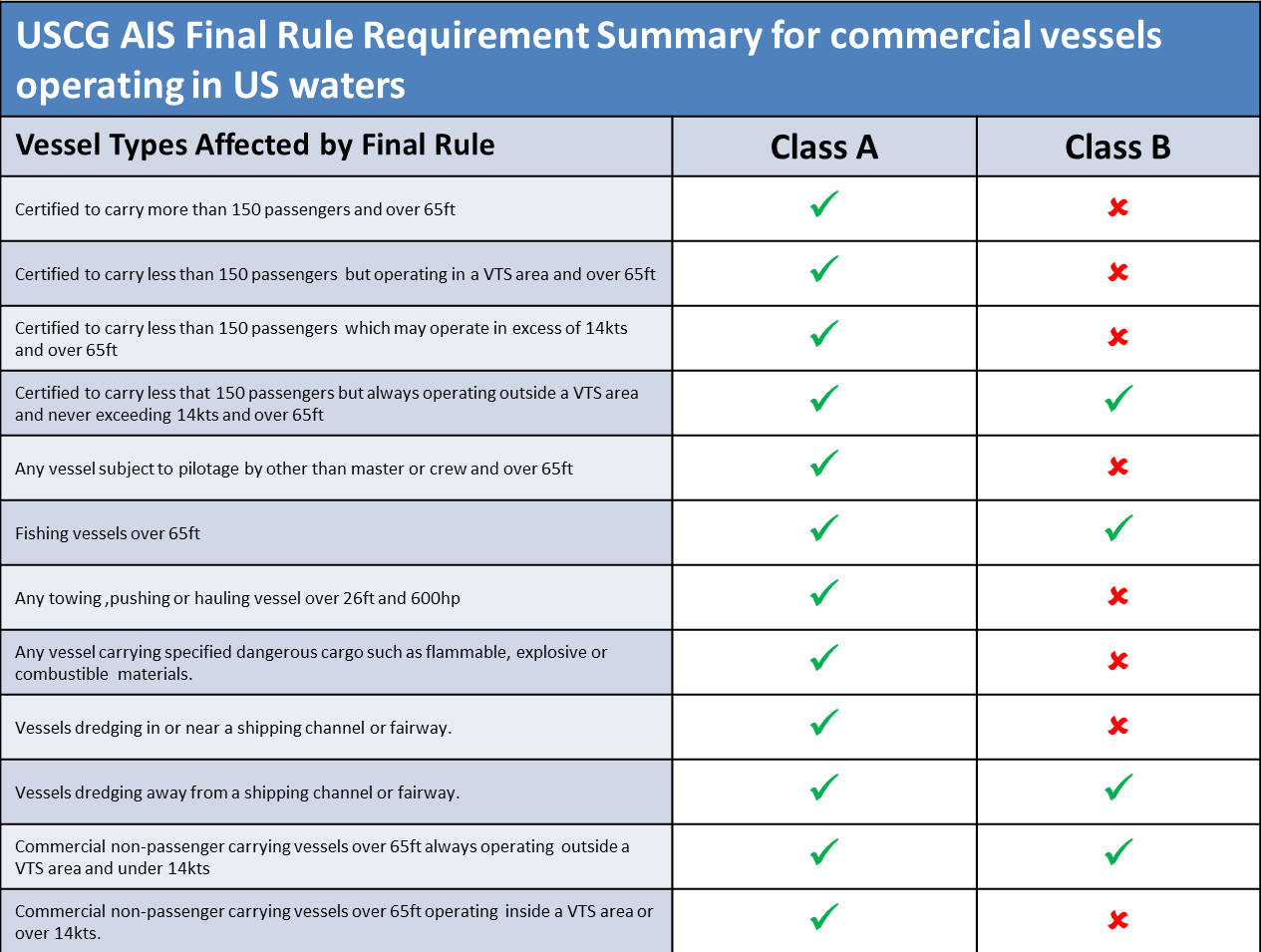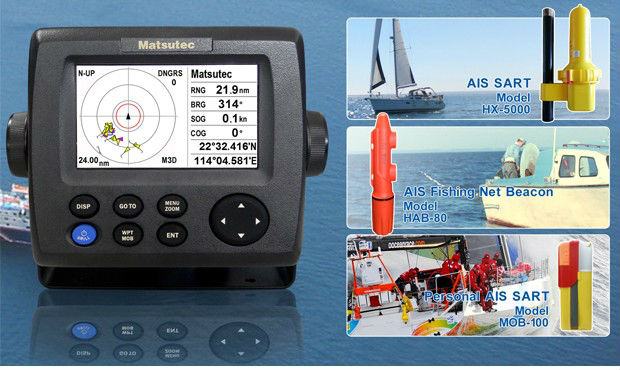GPS
with AIS transponder for small boats and
blue water sailor
Small boats and blue
water
sailor have one thing in common a small budget they
operate on and a high desire to increase the safety while under way.
Both a hard to overcome as
space is limited and the available resources need to provide the
biggest return / safety.
With
Dez. 2014 USCG AIS rules changed
AFFECTING COMMERCIAL VESSELS OPERATING IN U.S. WATERS
The USCG has officially published its Final Rule for the extension of
carriage requirements for AIS transceivers on commercial boats
operating in US waters.
The USCG AIS Rule comes into effect on 2nd March 2015 and requires all
those affected to have fitted the correct type of USCG certified AIS
transceiver no later than 2nd February 2016.
Within the Ruling the USCG also requires that all AIS transceivers are
correctly programmed and installed in accordance with their guidelines
or face the possibility of a $40,000 fine.
The conditions of the rule are summarised in the below USCG AIS Final Rule Summary Table.

With
the AIS B system aimed at lighter commercial and leisure markets new
products reach the market like the GPA-33
But with the AIS B system
aimed at lighter commercial and leisure markets new products reach
the market like the GPA-33
The GPA-33 is a 4.3"
color LCD display AIS B transponder combo with GPS navigator in a
small form factor like the Furuno GP-33 GPS it can be top mounted or
flush mounted.
With a
price of approximately 500,- per unit it should
allow small budget sailors to equip their vessel.

You
might ask how we can benefit from it and for that we need to
understand the AIS system
AIS
(or Automatic Identification System A or B ) is a international
transponder system for ships intending to increase the safety at sea
world wide.
It operates in the VHF band. The two frequencies used
worldwide are 161.975 and 162.025 MHz (channels 87B and 88B, or AIS1
and AIS2). The signal is transmitted via external VHF antenna and has
the reach of normal VHF signal in line of sight.
An AIS transmitter regularly transmits the ship's
position, heading, speed and MMSI (the unique maritime identification
number). This data is received by ships in the vicinity or land
stations.
Till
recently AIS equipment was cost-prohibitive for smaller vessels and
did not reach its recognition but was in service for the big
commercial fleet.
With
the recent addition of
personal
AIS devices designed to be fitted
to a life-jacket and assist in Man Overboard recovery it adds another
safety level to the crew on a vessel under way.
Lets
admit that in case you fall overboard the nearest rescue possibility
is the vessel you fell of ...as time passes the distance to this
vessel increases and the chances of MOB recovery decreases in the
same amount.
You most likely don’t fall overboard in
calm
conditions but your chances are higher in a bit rough conditions
where the line of sight is limited ..
The small PFD with strobe
only pops out of the swell from time to time. The AIS signal would
give a precise location on the vessels display at time of signal and
CoG to
make a interception of the MOB easier.
Most
sailors will desire to have one or the other kind of GPS on board for
position fix and ground made good.
If the same unit offers a AIS
without increasing the units expenses to much you will get the
benefits of both without additional hardware ...the GPA33A does just
that.
This
covers your personal gain in a short!
Add that the AIS would
allow a slower maneuvering vessel to find the space in the commercial
shipping lane to sail through without getting in the situation to
count the rivets on the bow of a commercial freighter who does not
even realize you are there ...
If you have your AIS unit turned on to
send signal ...he most likely is aware of you.
Entering
and leaving some ports where recreational and commercial traffic meet
in the same shipping lane due to spoil areas on both sides of them
will be easier with AIS.
Especially under limited visibility
as well
as identifying vessels approaching in your path and contacting them
with their unique MMSI....
If your vessle is used for recreation only, is not
required by law to carry a radio and does not make international
voyages or communications ..
Than you can request your MMSI through BoatUS for the
United States of America
But if you exceed these limitations than you are
legally required to obtain a Ship Station License from the FCC.They will issue an appropriate MMSI
with the License.
Appendix:
- Class A AIS :
- Vessel-mounted AIS transceiver
(transmit and receive) which operates using self-organised
time-division multiple-access (SOTDMA). Targeted at large
commercial vessels, SOTDMA requires a transceiver to maintain a
constantly updated slot map in its memory such that it has prior
knowledge of slots which are available for it to transmit. SOTDMA
transceivers will then pre-announce their transmission, effectively
reserving their transmit slot. SOTDMA transmissions are therefore
prioritised within the AIS system. This is achieved through 2 receivers
in continuous operation. Class A's must have an integrated display,
transmit at 12 W, interface capability with multiple ship systems,
and offer a sophisticated selection of features and functions. Default
transmit rate is every few seconds. AIS Class A type compliant devices
receive all types of AIS messages.
- Class B AIS:
- Vessel-mounted AIS transceiver
(transmit and receive) which operates using either carrier-sense
time-division multiple-access (CSTDMA)or SOTDMA; there are now 2
separate IMO specifications for Class B. Aimed at lighter commercial
and leisure markets. CSTDMA transceivers listen to the slot map
immediately prior to transmitting and seek a slot where the 'noise' in
the slot is the same or similar to background noise, thereby indicating
that the slot is not being used by another AIS device. Class Bs
transmit at 2 W and are not required to have an integrated
display: Class Bs can be connected to most display systems where the
received messages will be displayed in lists or overlaid on charts.
Default transmit rate is normally every 30 seconds, but this can be
varied according to vessel speed or instructions from base stations.
The Class B type standard requires integrated GPS and certain LED
indicators. Class B equipment receives all types of AIS messages.
For the AIS
1. Detail Target list and Radar overview
2. Watching display to monitor important
subject, example: Fishing
net buoy, Friend ship, Commercial traffic etc
3. External Alarm (Buzzer)
4. Low cost, reduced size and easy
installation make the HP-33A
ideal to meet your budgets and demands of owners and vessel operators
For the GPS
1. 4.3" Sunlight Viewable color LCD
(Brightness: 500 cd)
2. GOTO track navigation
3. Stores up to 10,000 marks/ waypoints,
100 routes and 3,000
track points
4. Dedicated Man Over Board Button (MOB)
5. Support NMEA 0183 ver 2.0
6. 7 display modes available, including
2 user-customized modes
7. SBAS capable for better measurement


